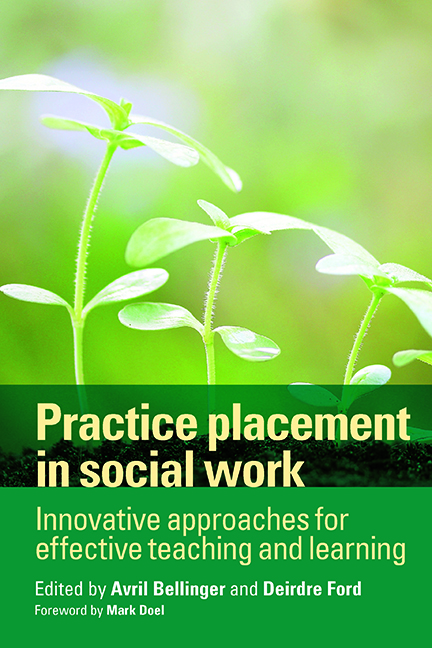Book contents
- Frontmatter
- Dedication
- Contents
- Foreword
- Notes on contributors
- Introduction
- One Student-led services
- Two International placements: learning from a distance
- Three The outside looking in – an independent social worker’s experience of practice educator work
- Four ‘Do you have to be white to pass this course?’ Developing support for black and minority ethnic students in a predominantly white area
- Five Men in social work education: building a gendered alliance
- Six Hidden in plain sight: use of an arts-based method for critical reflection
- Seven Getting our hands dirty: reconnecting social work education as if the earth matters
- Eight Social media for students in practice
- Nine Developing placement capacity in the third sector
- Ten Observations of student practice: what difference does observer qualification make?
- Eleven Filling the gap: constructive responses to the erosion of training standards for practice educators
- Twelve The concept of integrity in relation to failing and marginal students
- Thirteen Cultivating discretion: social work education in practice and the academy
- Index
One - Student-led services
Published online by Cambridge University Press: 01 September 2022
- Frontmatter
- Dedication
- Contents
- Foreword
- Notes on contributors
- Introduction
- One Student-led services
- Two International placements: learning from a distance
- Three The outside looking in – an independent social worker’s experience of practice educator work
- Four ‘Do you have to be white to pass this course?’ Developing support for black and minority ethnic students in a predominantly white area
- Five Men in social work education: building a gendered alliance
- Six Hidden in plain sight: use of an arts-based method for critical reflection
- Seven Getting our hands dirty: reconnecting social work education as if the earth matters
- Eight Social media for students in practice
- Nine Developing placement capacity in the third sector
- Ten Observations of student practice: what difference does observer qualification make?
- Eleven Filling the gap: constructive responses to the erosion of training standards for practice educators
- Twelve The concept of integrity in relation to failing and marginal students
- Thirteen Cultivating discretion: social work education in practice and the academy
- Index
Summary
Introduction
Applicants for social work courses will often explain their motivation as ‘wanting to make a difference’ in people's lives. Even in relatively resource-rich nations like the UK and Australia, there are deepening social inequalities and a tightening of access points to service entitlements. As state resources are reduced, preventive practice can be perceived as a luxury and problems are dealt with only when they reach crisis point. Practice education is an opportunity to harness students’ idealism, respond directly to need, redress social injustice, create positive alternatives and promote significant learning. Student-led services, staffed principally by students undertaking fieldwork placements, offer beneficial results both for society and for the quality of professional education. However, developing and maintaining this provision can be complex and challenging.
This chapter provides critical reflection on the common features of one student-led service in Australia and another in the UK. Both services operated for a number of years and each is the subject of publications (Butler, 2005, 2007; Testa, 2011). The phenomenon of student-led services is placed in the historical and international context of the health and social care literature. Each service is then described in sufficient detail for the reader to understand the origins of the initiative, the learning opportunities provided to students and its development over time. In conclusion, factors that are generative and protective of such innovations are identified in order to encourage others to take such initiatives.
Literature review
There is a well-established tradition of students on professional courses providing services to groups and communities as a mutually beneficial part of their training. Much of the literature originates in the US, where Moskowitz et al (2006) found that over 30 US medical schools had student-led clinics as part of the educational experience available to students. The health insurance system in the US has meant that, historically, people in poverty and those who were homeless were unable to access preventive health services. These communities are therefore the most likely to be served by student initiatives. They offer new entrants to the profession an introduction to the relationship between health and social justice (Marmot, 2005) while providing otherwise unavailable services to a group with complex needs. Research has shown that such exposure can result in higher levels of student professional satisfaction (Fournier et al, 1993) and may encourage graduates to work in similar settings when qualified (Tavernier et al, 2003).
- Type
- Chapter
- Information
- Practice Placement in Social WorkInnovative Approaches for Effective Teaching and Learning, pp. 5 - 20Publisher: Bristol University PressPrint publication year: 2016

